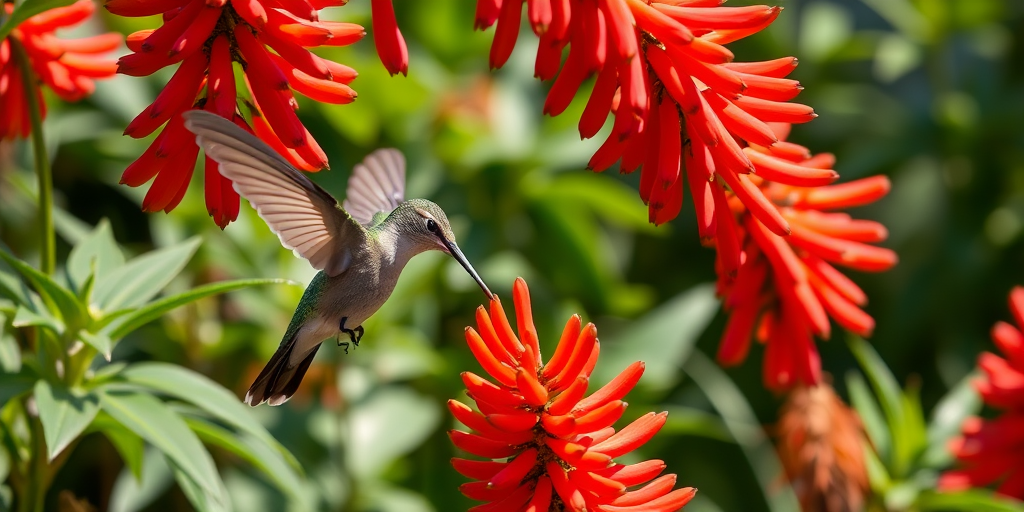Does your garden attract the vibrant flutter of hummingbirds? The right combination of nectar-rich blooms transforms outdoor spaces into lively sanctuaries for these feathered diners. Select tubular, brightly colored flowers that maintain a predictable bloom cycle to provoke feeding instincts naturally. This article presents a practical guide to addressing the unique dietary demands of nectar-loving birds through strategic plant choices and thoughtful garden layouts. Bird enthusiasts will gain insights into planting techniques that elevate backyard birding into an experience of continuous delight.
Top Flowering Plants to Attract Nectar-Loving Birds
Gardens featuring high-yield nectar plants provide an optimal feeding environment for hummingbirds and similar species. These flowering choices are designed to accommodate rapid nectar consumption and vibrant visual stimuli. A range of carefully selected blooms supports continuous nectar availability, ensuring birds access food resources throughout extended seasons. Gardeners may incorporate these vibrant species to form a concentrated nectar zone that stimulates regular feeding activity among avian visitors. The plants not only display brilliant color cues that trigger feeding but also exhibit structural traits such as extended flower throats or compact sizes that facilitate efficient nectar extraction. Below is a list of recommended flowering plants that have been proven effective in attracting nectar-loving birds:
- Deep orange cigar-shaped flower – constant summer blooms
- 2–3 feet tall compact bloomers – long flowering season
- Tubular petunias – available in red, yellow, pink, and purple
- Two-toned varieties with tangerine and creamy white blooms – early summer starter that reblooms
- Fast-growing perennial options that ensure nectar supply
- Fragrant nectar-rich blossoms ideal for feeding
- Supplemental edible nectar sources that support bird nutrition
These plants are particularly suitable for areas with ample sunlight during summer heat, offering not only aesthetic appeal but also a lasting food supply. Their continuous blooming patterns create a reliable nectar source and promote sustained bird activity within the garden. Selection of these species reinforces the overall habitat strategy, providing both nectar production and visual interest. Gardeners can thereby foster an environment that accommodates high feeding frequencies, fulfilling the nutritional requirements of hummingbirds and other nectar-dependent species.
Planting and Garden Setup for Nectar-Loving Birds

A well-planned garden layout is crucial for attracting nectar-dependent birds. Precise spacing and thoughtful placement of flowering species intensify bird visits by clustering blooms that provide continuous nectar access. Arranging plants to form concentrated feeding zones also minimizes the effort birds expend while foraging. Garden design for bird magnetism directly influences how effectively birds locate and consume nectar during all daylight hours.
Seasonal Bloom Strategies
Adjusting planting calendars is a practical method to sustain nectar availability across seasons. Gardeners are encouraged to schedule plantings that cover early, mid, and late-season flowering to guarantee ongoing food sources. This tactic synchronizes blooming patterns with the feeding behavior of migrating and resident bird species.
- Group similar nectar-producing plants together
- Consider companion planting with insect-friendly herbs
- Use raised beds for optimized soil drainage
- Plan for periodic maintenance to remove spent blooms
- Integrate water-efficient irrigation methods
Incorporating these actionable strategies results in a garden layout that continuously attracts hummingbirds and similar species. The careful placement of tubular flowers encourages regular visits by ensuring that multiple nectar sources are available simultaneously. Strategic grouping creates an environment where birds can feed with minimal disruption while benefitting from overlapping bloom periods throughout the day. The use of raised beds and companion planting supports optimal soil conditions that enhance plant health and promote robust flowering. As a result, the garden evolves into a dependable haven that supplies a consistent nectar flow, meeting the high metabolic demands of nectar-loving birds and fostering a lively and sustainable outdoor habitat.
Final Words
In the action of exploring vibrant blooms and adaptable garden configurations, the article outlined techniques for attracting nectar-loving birds while balancing seasonal blooms and sustainability.
Key insights covered: • Selecting tubular, colorful blooms
• Clustering plants to maintain a steady nectar supply
• Integrating native and waterwise species for resilient gardens
By employing the Best Plants to Attract Nectar-Loving Birds, enthusiasts can create thriving habitats that promote both ecological balance and rewarding outdoor experiences.
FAQ
Q: What are the best plants to attract nectar-loving birds?
A: Coneflowers, Zinnias, Asters, Sunflowers, and Beebalms are top choices. These plants produce abundant nectar and feature tubular or cup-shaped flowers in bright colors that attract hummingbirds and other nectar-feeding birds.
Q: Which plants attract both birds and butterflies?
A: Native flowering plants like Marigolds, Zinnias, and Coneflowers attract both birds and butterflies. These plants provide nectar-rich blooms and feature landing platforms suitable for both species.
Q: What plants work best for birds’ nesting needs?
A: Dense shrubs and small trees provide ideal nesting spots. Plants with sturdy branches and protective foliage, such as native evergreens and flowering shrubs, offer secure locations for bird nests.
Q: What are the benefits of planting nectar-producing flowers?
A: Nectar-producing flowers support bird population health, increase garden biodiversity, and promote natural pollination. These plants create sustainable food sources for various bird species throughout growing seasons.
Q: What features should nectar-rich plants have?
A: Effective nectar plants should have tubular or cup-shaped flowers, display bright colors (especially red, orange, or yellow), and offer extended blooming periods for consistent nectar production.
Q: How should nectar plants be arranged in a garden?
A: Group similar nectar-producing plants in clusters, create staggered blooming schedules, and include various flower heights. This arrangement maximizes nectar availability and attracts more birds.


